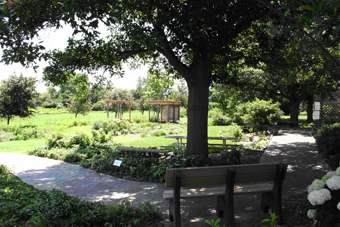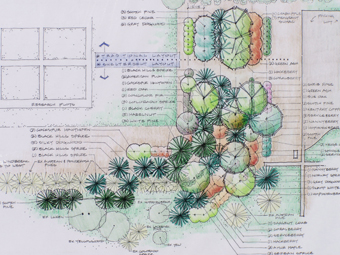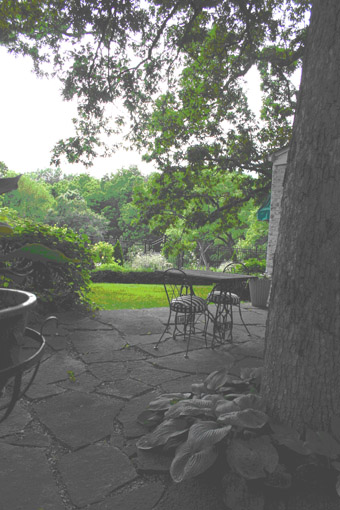G1747
Trees in the Home Landscape
Trees are important components of home landscapes. They can increase the livability and value of a home, provide environmental benefits, attract wildlife, and increase the overall beauty of the landscape. This NebGuide will describe the functional and aesthetic benefits of using trees in the home landscape, as well as explain basic growth and maintenance requirements for healthy trees.
Anne M. Streich, Extension Horticulture Educator
Steve N. Rodie, Extension Landscape Horticulture Specialist
|
Functional Uses of Trees
Provide shade. Trees can alter the temperature of outdoor living spaces, making them cooler and more usable during the summer (Figure 1). Trees and other landscape plants are more successful in reducing air temperatures than built structures are, due to transpiration (water loss through leaves which creates a natural “air conditioning” effect) that occurs in plants.
Shade patterns cast by trees will change depending on the time of day and season. Afternoon sun in mid-summer will produce the smallest shade pattern due to the sun’s high location in the sky and will cast shade to the north/northeast. As a result, large shade trees planted on the south or southwest sides of a home can help cool the home and reduce energy costs during the summer.
Low sun angles during the winter will produce the largest shade patterns. As deciduous trees planted on the south and southwest sides of the home lose their vegetation in the fall, the winter sun will provide some heat to the home.
Key factors in selecting shade trees to be planted on the south and southwest sides of a home include selecting trees with wide upright or vase-shaped growth habits and avoiding trees with evergreen foliage or persistent leaves.
|
Trees with wide upright or vase-shaped growing habits will maximize shade coverage on the house during the summer, while trees with persistent leaves (leaves that tend to stay on the tree through winter) will cast shade on the house rather than letting the sunlight warm the house in the winter. Examples of large shade trees that grow well in Nebraska include maples, ginkgo, Kentucky coffeetree, honeylocust, walnut, and hackberry. Oaks (excluding pin, shingle and sawtooth oak, which tend to have persistent leaves) also make quality shade trees.
Provide wind protection. Trees can be used to buffer or direct winds to benefit outdoor living spaces (Figure 2). Cold winter winds originate from the north/northwest and can be blocked or slowed with a combination of evergreen and deciduous trees and shrubs planted on the north and west sides of a home. Multiple rows are not necessary for blocking wind, but do increase the ability to slow and divert winds for a greater distance than a single row or two can. Important windbreak considerations include diverse tree species selection and proper placement for maximized benefits and minimized snow drifting and other maintenance issues. Planting several trees of one species can be problematic when insects or diseases occur.
For more information about windbreaks, see the UNL Extension NebGuide series on windbreaks located at: http://extension.unl.edu/publications under the forestry subdivision. This series includes information on windbreak design, establishment, management, renovation, and attracting wildlife.
Provide framework. Trees contribute to the visual quality of a landscape through their size, form, texture and color. Among these four factors, size is the most important visual contribution to the landscape framework. Trees provide framework for the entire landscape and are often the first plant noticed when viewing a home landscape from a distance. Select trees that are suited for a space, even as they continue to grow. Avoid placing trees too close to the home, as they can cause damage to the roof and fill gutters with plant debris. Plant trees at a minimum distance of half the mature canopy width away from the home. Due to environmental stresses and climatic extremes in Nebraska, trees planted in Nebraska rarely reach the expected heights and widths stated in non-Nebraska plant references. When such references are used, the mature size of a tree can typically be reduced to 75 percent of its stated height and width.
Provide scale. Trees can create a variable sense of scale on a property, and can either help emphasize or de-emphasize the home and help it blend into the landscape. Tree distances from the home, home location on the site, and site slopes can all affect property scale.
Generally, homes that are placed near the top of hills, and have only small trees planted around them tend to appear very dominant. On large lots in town or in large open spaces in the country, trees not only need to be planted near the home but be incorporated into the landscape away from the house. Planting away from the house and in groupings of trees and other landscape plants will help the house blend into the surrounding landscape and avoid making the house appear too dominant.
Conversely, large trees planted near a home may make the home appear very small, especially if it is a single-story house. Placing large trees far enough away from single story homes to prevent them from dwarfing the house can be difficult. To some, this is a less serious problem because of the many benefits trees provide in making the landscape more comfortable to use and grow plants.
Define space/provide privacy. Another major function of trees in home landscapes is the provision of “ceilings” and “walls” to outdoor rooms. “Ceilings” can be created by enclosing the overhead space with tree canopies. Canopy height can impact how the space feels. Overhead canopy heights 12 feet or lower create intimate outdoor rooms, while canopies greater than 12 feet create an open feeling (Figure 3).
“Walls” can be created by using small trees with upright form and relatively dense foliage or by creating an implied wall or edge with closely-spaced tree trunks or multiple-trunked trees. When using trees to screen views and enhance privacy, strategic locations should be selected to enhance screening value. Small trees placed closer to the living area will simultaneously define space and provide privacy while still allowing outward views (Figure 4).
Aesthetic Uses of Trees
Soften architecture. Trees and other landscape plants can be used to visually soften the corners of houses. Select plants that are approximately 2/3 the height of the eave. Shorter plants are not visually pleasing, while taller plants may dwarf the house (Figure 5). Rounded forms are more effective than pyramidal or conical-shaped plants. Trees are also effective in visually breaking up large facades created on house ends of two-story and walkout homes.
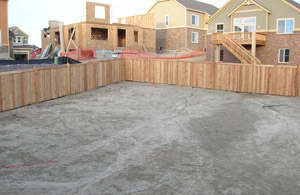 |
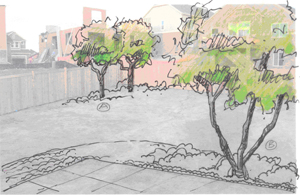 |
| Figure 4. The left photo shows the potential lack of privacy due to neighbor views from windows and deck. The right photo shows two tree locations that will enhance privacy; a tree at location A will also strongly define space. | |
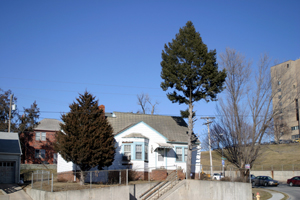 |
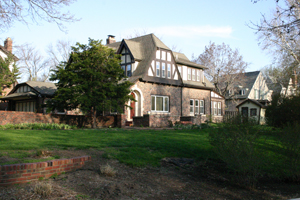 |
| Figure 5. The trees in the left picture were planted too close to the house and are out of scale with the house; the evergreen tree on the corner of the house in the picture on the right is in proper scale. | |
Enframe views. Trees planted in the backyard can successfully enframe a house when viewed from the street/road. Trees can also be used to enframe views from inside of the home looking out into the landscape. Avoid planting trees directly in the middle of the front yard, as that visually divides the view of the house. Instead, trees used in the front yard should be used to enframe the entire house, front walk and/or entrance (Figure 6).
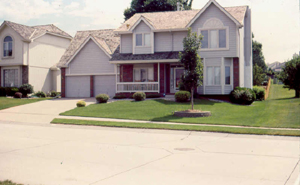 |
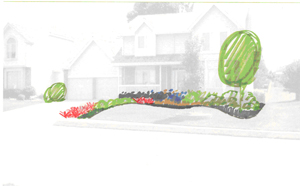 |
| Figure 6. Front yard trees, especially where they will not shade the house, are best planted to enframe house corners (right) rather than break up views of the house (left). | |
Accent. Trees can be used as accents. This is commonly done with tree form. In Nebraska, the most dominant tree forms are round and spreading. Because of their commonness, they do not attract attention. Other shapes that are uncommon in Nebraska, such as columnar (Taylor juniper), pyramidal (spruces, linden), weeping (weeping willow) or picturesque (Japanese treelilac), can be used to draw attention to an area.
Accents can also be accomplished with attractive bark, flowers, fruits, fragrance or leaves, although some of these plant characteristics are only evident for short periods. An accent tree may be strategically located to be viewed from inside and outside of the house. The number of accent plants should be minimized in small areas. A landscape containing several accent plants will seem visually chaotic if they can all be seen at the same time. As the space gets larger and more landscape “rooms” are created, more accent plants can be used.
Other Considerations
Restricted Rootzones. The amount and quality of underground rooting space impacts tree growth. Tree roots are typically found in the top 18 inches of soil and often extend past the canopy. Trees growing in restricted rootzones, such as between the sidewalk and street, or in new subdivisions with compacted sub-soil, often succumb to pests quicker, exhibit slower growth rates, and reach shorter mature heights than trees growing in open spaces.
Reduce maintenance. Selecting native or adapted trees is important for long-term survival and reduced maintenance. Site conditions, such as soil type and pH, moisture availability, sun and wind exposure, and pest susceptibility are important factors to consider before selecting and planting trees. Without carefully analyzing these conditions, increased maintenance and decreased plant vigor may occur. In addition, tree characteristics such as branching height, fruit persistence, and leaf drop timing are important items to consider. For example, trees that have heavy fruit fall are not desirable near sidewalks or decks and trees that have low branching habits will require more pruning when planted near a sidewalk or in front of a window.
Proper planting and initial pruning. Proper tree planting is critical to a tree’s future success. Considerations such as planting too deep, improper staking, and inconsistent watering can inhibit healthy tree establishment and lead to long-term tree decline and additional maintenance requirements. Early tree pruning, if done properly, can significantly minimize future maintenance problems such as double leaders, which can lead to weak branch structure. Corrective pruning at an early age is much simpler and more cost-effective than corrective pruning of a large established tree that develops structural, form or environmental damage over time. Proper tree management and pruning information can be found in the publication section of the Nebraska Forest Service Web site, www.nfs.unl.edu.
Safety/Health. Fast-growing trees, such as silver maple and poplars, typically possess weak wood and are often short-lived. In addition, trees with narrow crotch angles are susceptible to limb damage from snow/ice storms due to weak branch connections. Pruning can help eliminate narrow branch attachments, but some trees, such as yellowwood and Bradford pear, inherently have narrow crotch angles and pruning will not be a solution. Fast-growing trees and trees with narrow crotch angles should be planted away from houses and other buildings to avoid potential damage from falling limbs. Under good growing conditions, trees known for slow growth rates, such as oaks, can grow up to two feet per year, and will provide long-term benefits. Asthma/allergy sufferers should avoid planting seedless or fruitless tree cultivars, which often have staminate (male) flowers that produce pollen.
Competition. Trees with large leaves and dense canopies, such as maples and lindens, produce dense shade, making it difficult to grow grass or other plants under their canopies. Airy, fine-textured trees, such as honeylocust, are more conducive to understory planting. In addition, certain tree species, such as poplars and maples, typically exhibit shallow roots that extend above the soil surface as they mature, making it difficult to mow under the canopy or incorporate other landscape plants.
It is best to develop a mulched landscaped bed in areas where tree roots are exposed to reduce potential mower damage to the roots. The NebGuide, Landscaping Around Established Trees (G1452), provides additional information about tree root growth and how to avoid tree damage when landscaping around mature trees.
Utilities. Avoid overhead and buried utility lines. The Digger’s Hotline (800-331-5666) should be called before digging to plant trees or other landscape plants. In addition, avoid planting trees near septic tank/drain field systems. Shallow-rooted fast-growing trees such as willows and cottonwoods, which naturally prefer high soil moisture, can be especially problematic in these areas. Trees should be planted minimally 5-10 feet away from the septic field edge, although greater distances would be desirable, if possible.
Summary
Mature trees make significant visual and environmental enhancements to the landscape. Properly selecting tree species and identifying ideal planting locations around the house will maximize visual interest, reduce long-term maintenance, and improve microclimate conditions for many years. Unfortunately, trees can rarely be placed to meet all desired aesthetic and functional requirements, nor can one “perfect” tree species be selected that isn’t without limitations or maintenance issues. As a result, decisions must be made on species selection and location based on a cost/benefit analysis that will be unique for each landscape situation.
Visit the University of Nebraska–Lincoln Extension Publications Web site for more publications.
Index: Lawn & Garden
Ornamentals
Issued August 2007
